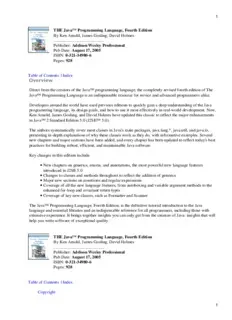
THE Java™ Programming Language, Fourth Edition PDF
Preview THE Java™ Programming Language, Fourth Edition
1 THE Java™ Programming Language, Fourth Edition By Ken Arnold, James Gosling, David Holmes ............................................... Publisher: Addison Wesley Professional Pub Date: August 17, 2005 ISBN: 0-321-34980-6 Pages: 928 Table of Contents | Index Direct from the creators of the Java™ programming language, the completely revised fourth edition of The Java™ Programming Language is an indispensable resource for novice and advanced programmers alike. Developers around the world have used previous editions to quickly gain a deep understanding of the Java programming language, its design goals, and how to use it most effectively in real-world development. Now, Ken Arnold, James Gosling, and David Holmes have updated this classic to reflect the major enhancements in Java™ 2 Standard Edition 5.0 (J2SE™ 5.0). The authors systematically cover most classes in Java's main packages, java.lang.*, java.util, and java.io, presenting in-depth explanations of why these classes work as they do, with informative examples. Several new chapters and major sections have been added, and every chapter has been updated to reflect today's best practices for building robust, efficient, and maintainable Java software. Key changes in this edition include • New chapters on generics, enums, and annotations, the most powerful new language features introduced in J2SE 5.0 • Changes to classes and methods throughout to reflect the addition of generics • Major new sections on assertions and regular expressions • Coverage of all the new language features, from autoboxing and variable argument methods to the enhanced for-loop and covariant return types • Coverage of key new classes, such as Formatter and Scanner The Java™ Programming Language, Fourth Edition, is the definitive tutorial introduction to the Java language and essential libraries and an indispensable reference for all programmers, including those with extensive experience. It brings together insights you can only get from the creators of Java: insights that will help you write software of exceptional quality. THE Java™ Programming Language, Fourth Edition By Ken Arnold, James Gosling, David Holmes ............................................... Publisher: Addison Wesley Professional Pub Date: August 17, 2005 ISBN: 0-321-34980-6 Pages: 928 Table of Contents | Index Copyright 1 2 The Java™ Series Preface About This Book Examples and Documentation Acknowledgments (Fourth Edition) Acknowledgments (Third Edition) Acknowledgments (Second Edition) Acknowledgments (First Edition) Chapter 1. A Quick Tour Section 1.1. Getting Started Section 1.2. Variables Section 1.3. Comments in Code Section 1.4. Named Constants Section 1.5. Unicode Characters Section 1.6. Flow of Control Section 1.7. 2 3 Classes and Objects Section 1.8. Methods and Parameters Section 1.9. Arrays Section 1.10. String Objects Section 1.11. Extending a Class Section 1.12. Interfaces Section 1.13. Generic Types Section 1.14. Exceptions Section 1.15. Annotations Section 1.16. Packages Section 1.17. The Java Platform Section 1.18. Other Topics Briefly Noted Chapter 2. Classes and Objects Section 2.1. 3 4 A Simple Class Section 2.2. Fields Section 2.3. Access Control Section 2.4. Creating Objects Section 2.5. Construction and Initialization Section 2.6. Methods Section 2.7. this Section 2.8. Overloading Methods Section 2.9. Importing Static Member Names Section 2.10. The main Method Section 2.11. Native Methods Chapter 3. Extending Classes Section 3.1. An Extended Class Section 4 5 3.2. Constructors in Extended Classes Section 3.3. Inheriting and Redefining Members Section 3.4. Type Compatibility and Conversion Section 3.5. What protected Really Means Section 3.6. Marking Methods and Classes final Section 3.7. Abstract Classes and Methods Section 3.8. The Object Class Section 3.9. Cloning Objects Section 3.10. Extending Classes: How and When Section 3.11. 5 6 Designing a Class to Be Extended Section 3.12. Single Inheritance versus Multiple Inheritance Chapter 4. Interfaces Section 4.1. A Simple Interface Example Section 4.2. Interface Declarations Section 4.3. Extending Interfaces Section 4.4. Working with Interfaces Section 4.5. Marker Interfaces Section 4.6. When to Use Interfaces Chapter 5. Nested Classes and Interfaces Section 5.1. Static 6 7 Nested Types Section 5.2. Inner Classes Section 5.3. Local Inner Classes Section 5.4. Anonymous Inner Classes Section 5.5. Inheriting Nested Types Section 5.6. Nesting in Interfaces Section 5.7. Implementation of Nested Types Chapter 6. Enumeration Types Section 6.1. A Simple Enum Example Section 6.2. Enum Declarations Section 6.3. Enum Constant Declarations Section 6.4. java.lang.Enum 7 8 Section 6.5. To Enum or Not Chapter 7. Tokens, Values, and Variables Section 7.1. Lexical Elements Section 7.2. Types and Literals Section 7.3. Variables Section 7.4. Array Variables Section 7.5. The Meanings of Names Chapter 8. Primitives as Types Section 8.1. Common Fields and Methods Section 8.2. Void Section 8.3. Boolean Section 8.4. Number 8 9 Section 8.5. Character Section 8.6. Boxing Conversions Chapter 9. Operators and Expressions Section 9.1. Arithmetic Operations Section 9.2. General Operators Section 9.3. Expressions Section 9.4. Type Conversions Section 9.5. Operator Precedence and Associativity Section 9.6. Member Access Chapter 10. Control Flow Section 10.1. Statements and Blocks Section 10.2. ifelse Section 10.3. switch Section 10.4. 9 10 while and dowhile Section 10.5. for Section 10.6. Labels Section 10.7. break Section 10.8. continue Section 10.9. return Section 10.10. What, No goto? Chapter 11. Generic Types Section 11.1. Generic Type Declarations Section 11.2. Working with Generic Types Section 11.3. Generic Methods and Constructors Section 11.4. Wildcard Capture Section 11.5. Under the Hood: Erasure 10
